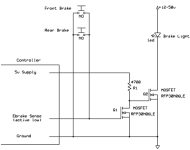socrace said:
In either case, the front and rear ebrake switches are wired in series and normally closed, so if either one opens, the signal goes from 0 to 5v and triggers the ebrake function.
that's a strange way to wire the system. iv'e never seen this kind if wiring or operation on the ebikes i've worked on or built.
on every controller i've got or used, prebuilt oem bikes or kits or random generic controllers, the ebrake switches are wired in parallel, and are normally open. when the brake lever is pulled, the switch closes, and shorts the signal wire to ground.
the one different style is when a 3-wire brkae switch is used, and it's a hall effect sensor in the brake lever. for these, there's 5v, signal, and ground, but the hall sensor still just grounds the signal line, so a regular brake switch between signal and ground still works.
as far as the voltage rating of the switch, you're likely right, but there are no markings on any of the switches i've ever seen in these ebrake levers, so there's no way to know what their rating actually is without destructive testing.

since there is very little current used, in the milliamp range or less, it's likely that for the original use the voltage would be ok at 48v. but if high current is needed for the brake light, the switch would need to be changed to a different one capble of the higher ovltage and current, or a relay could be used instead, and the relay coil switched by the brake swithc. i've done that myself for such things, like my sb cruiser ligthing, which uses autmotive relays for switching the lighting.
a fet can also be used like you show in your diagram, but would need something else on the switch to change it's grounding function to a 5v output function, like a pnp transistor with it's base to the signal wire, emitter to 5v, and collector to ground and the fet gate input.

